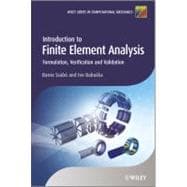
What is included with this book?
Ivo Babuška’s research has been concerned mainly with the reliability of computational analysis of mathematical problems and their applications, especially by the finite element method. He was the first to address a posteriori error estimation and adaptivity in finite element analysis. His research papers on these subjects published in the 1970s have been widely cited. His joint work with Barna Szabó on the p-version of the finite element method established the theoretical foundations and the algorithmic structure for this method. His recent work has been concerned with the mathematical formulation and treatment of uncertainties which are present in every mathematical model. In recognition of his numerous important contributions, Professor Babuška received may honors, which include honorary doctorates, medals and prizes and election to prestigious academies.
Series Preface.
Preface.
1 Introduction.
1.1 Numerical simulation.
1.2 Why is numerical accuracy important?
1.3 Chapter summary.
2 An outline of the finite element method.
2.1 Mathematical models in one dimension.
2.2 Approximate solution.
2.3 Generalized formulation in one dimension.
2.4 Finite element approximations.
2.5 FEM in one dimension.
2.6 Properties of the generalized formulation.
2.7 Error estimation based on extrapolation.
2.8 Extraction methods.
2.9 Laboratory exercises.
2.10 Chapter summary.
3 Formulation of mathematical models.
3.1 Notation.
3.2 Heat conduction.
3.3 The scalar elliptic boundary value problem.
3.4 Linear elasticity.
3.5 Incompressible elastic materials.
3.6 Stokes' flow.
3.7 The hierarchic view of mathematical models.
3.8 Chapter summary.
4 Generalized formulations.
4.1 The scalar elliptic problem.
4.2 The principle of virtual work.
4.3 Elastostatic problems.
4.4 Elastodynamic models.
4.5 Incompressible materials.
4.6 Chapter summary.
5 Finite element spaces.
5.1 Standard elements in two dimensions.
5.2 Standard polynomial spaces.
5.3 Shape functions.
5.4 Mapping functions in two dimensions.
5.5 Elements in three dimensions.
5.6 Integration and differentiation.
5.7 Stiffness matrices and load vectors.
5.8 Chapter summary.
6 Regularity and rates of convergence.
6.1 Regularity.
6.2 Classification.
6.3 The neighborhood of singular points.
6.4 Rates of convergence.
6.5 Chapter summary.
7 Computation and verification of data.
7.1 Computation of the solution and its first derivatives.
7.2 Nodal forces.
7.3 Verification of computed data.
7.4 Flux and stress intensity factors.
7.5 Chapter summary.
8 What should be computed and why?
8.1 Basic assumptions.
8.2 Conceptualization: drivers of damage accumulation.
8.3 Classical models of metal fatigue.
8.4 Linear elastic fracture mechanics.
8.5 On the existence of a critical distance.
8.6 Driving forces for damage accumulation.
8.7 Cycle counting.
8.8 Validation.
8.9 Chapter summary.
9 Beams, plates and shells.
9.1 Beams.
9.2 Plates.
9.3 Shells.
9.4 The Oak Ridge experiments.
9.5 Chapter summary.
10 Nonlinear models.
10.1 Heat conduction.
10.2 Solid mechanics.
10.3 Chapter summary.
A Definitions.
A.1 Norms and seminorms.
A.2 Normed linear spaces.
A.3 Linear functionals.
A.4 Bilinear forms.
A.5 Convergence.
A.6 Legendre polynomials.
A.7 Analytic functions.
A.8 The Schwarz inequality for integrals.
B Numerical quadrature.
B.1 Gaussian quadrature.
B.2 Gauss–Lobatto quadrature.
C Properties of the stress tensor.
C.1 The traction vector.
C.2 Principal stresses.
C.3 Transformation of vectors.
C.4 Transformation of stresses.
D Computation of stress intensity factors.
D.1 The contour integral method.
D.2 The energy release rate.
E Saint-Venant's principle.
E.1 Green's function for the Laplace equation.
E.2 Model problem.
F Solutions for selected exercises.
Bibliography.
Index.
The New copy of this book will include any supplemental materials advertised. Please check the title of the book to determine if it should include any access cards, study guides, lab manuals, CDs, etc.
The Used, Rental and eBook copies of this book are not guaranteed to include any supplemental materials. Typically, only the book itself is included. This is true even if the title states it includes any access cards, study guides, lab manuals, CDs, etc.